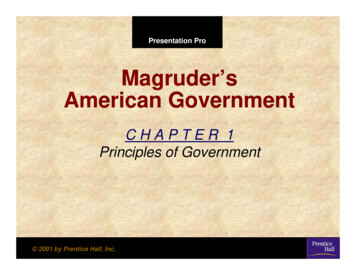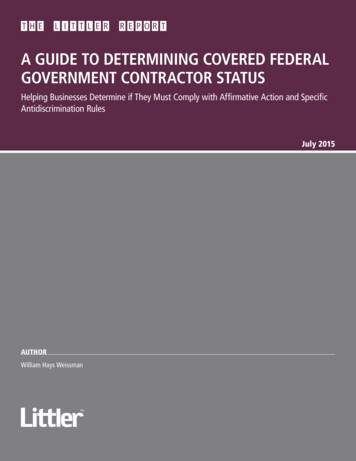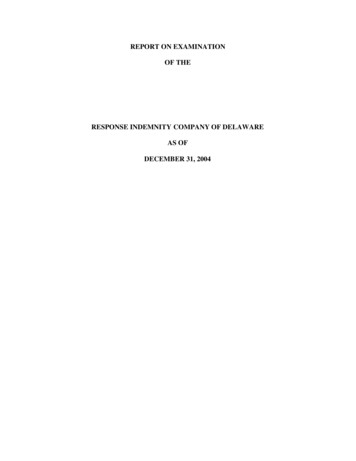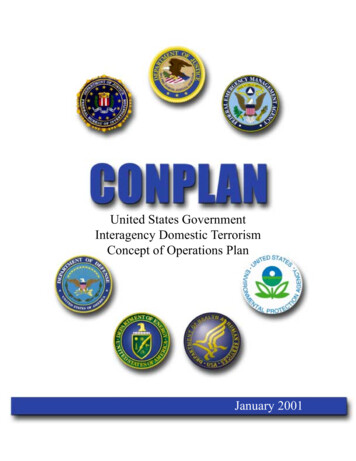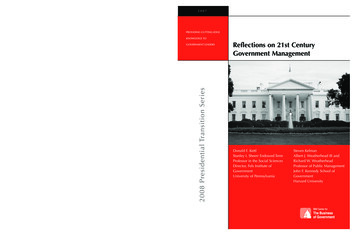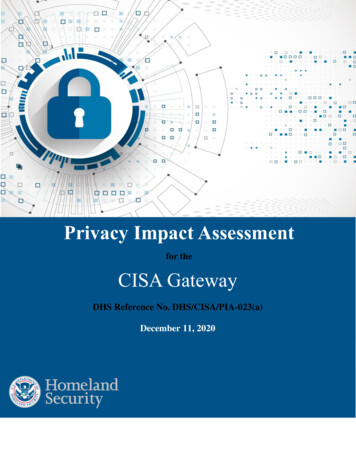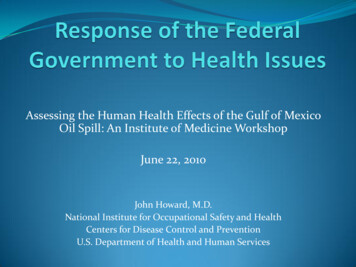
Transcription
Assessing the Human Health Effects of the Gulf of MexicoOil Spill: An Institute of Medicine WorkshopJune 22, 2010John Howard, M.D.National Institute for Occupational Safety and HealthCenters for Disease Control and PreventionU.S. Department of Health and Human Services
Federal Government Health Response: Overall Goals Prevent injury, illness and disability as a result of thespill and its consequences. Monitor short- and long-term health of affectedpopulations. Ensure care for those who need it, includingbehavioral health care, for spill-related problems. Anticipate and mitigate problems that could arise.
Populations of Concern
Overview of Federal Health Agency Activities Disseminating Information on Health Risks (All Federal Agencies, State andLocal Health Departments) Protecting Workers, Volunteers and Residents (Coast Guard, OSHA, FDA,NOAA, CDC, SAMSHA, State and Local Health Departments) Training Workers to maximize their safety during response (NIH/NIEHS,OSHA) Monitoring Exposures of Workers and the Public (Coast Guard, EPA, OSHA,CDC/NCEH, CDC/NIOSH) Monitoring Population Health (CDC, State and Local Health Departments,FDA, SAMSHA) Providing Medical Care (ASPR/NDMS, State and Local Health Departments) Preparing for Long Term Follow-up (NIH, CDC, State and Local HealthDepartments)
Potential Worker Exposures On WaterSource Control Vessels Closest to the area where crude oil appears on the surface, e.g. drillingrelief wells, applying underwater subsurface dispersants, providingsupport and supplies. These vessels have contact with fresh crude oil,VOCs, explosive vapors, and concentrated dispersant chemicals.Vessels Involved in Burning Crude Oil Exposed to crude oil/dispersant that is less aged and may emit moreVOCs than crude/dispersant closer to shore. Other hazards include heat,exposure to combustion products and, rarely, flash fire.Vessels Involved in Removing Oil from the Water Involved in containment, booming and skimming, distant from source orburning. Generally, these vessels have contact with oil that hasweathered, and, as such, does not emit significant amounts of VOCs.
Potential Worker Exposures On LandShoreline Cleanup Activities: These workers engage in manual removalof oiled-contaminated sand, low pressure flushing, manual sorbentapplication, and manual cutting of vegetation. Heat stress is asignificant hazard.Decontamination Activities: Vessels, PPE and other equipment maybecome contaminated during cleanup activities with weathered oil.This must be removed before leaving the contaminated areas.Workers and volunteers may also be involved in cleaning and caringfor oil-soiled birds, turtles and other wildlife prior to relocation to thewild.Waste Stream Management Activities: Response and remediationworkers are engaged in the centralized disposal and recycling ofhazardous solid and liquid wastes during collection, storage, transportand final disposal.
Potential Exposures of Community Residents Dermal exposure to weathered crude in the water(through swimming) or on the beaches (by walking orsunbathing or touching weathered crude) Inhalational exposure to hydrocarbons and theirirritant odors from close proximity or from prevailingwinds Ingestion by eating potentially contaminated seafood,especially from non-commercial sources Psychological stress from social and economicdisruption, and uncertainty about the future
Unified Command:Overall Incident CoordinationDepartment of Homeland Security. The Department ofHomeland Security is the principal Federal agency fordomestic incident management. The Unified Command forthe Deepwater Horizon Response incorporates all federalcomponents and operates under the direction of Coast GuardAdmiral Thad Allen.See 31/.Coast Guard. In addition to overall incident management, theCoast Guard is engaged in a activities to protect its workers.Through the Unified Command, it posts health and safetyinformation, including worker/volunteer health and safetyinformation, on its website.See 1/567723 2931/567787/
Federal Health Activity CoordinationIn coordination with Unified Command: White House Domestic Policy Council Health-related activities of all Cabinet-leveldepartments and Federal health agencies HHS Assistant Secretary for Preparedness & Response CDC/NIOSH, CDC/NCEH, NIH/NIEHS, FDA, HRSA,SAMHSA, ACF, CMS, ASPR/NDMS
Environmental Monitoring: EPA and NOAA Monitoring exposures in air, water, sediment and wastestream. Collecting samples along the shoreline and beyond forchemicals related to oil and dispersants in the air, waterand sediment NOAA: Aerial monitoring by NOAA P-3 aircraft (60 metersabove surface) for air toxics Supporting and advising Coast Guard efforts to clean thereclaimed oil and waste from the shoreline Closely monitoring the effects of dispersants in thesubsurface environment. All data regularly posted and publicly available. See http://www.epa.gov/bpspill/
Worker Protection: U.S. Coast Guard Ensuring all aspects of marine safety and fire control Ensuring port and tanker safety Monitoring vessel decontamination procedures Monitoring the safe operation of all U.S. Flag vessels and offshorefacilities Setting priorities for protecting human health, welfare and theenvironment through the Unified Command Protects all Coast Guard personnel by monitoring exposures andby means of established occupational safety and health programs Provides senior safety officials to work with BP Safety, OSHA,CDC/NIOSH and other Federal, State and local healthdepartments
Worker Protection: DOL/OSHA & NIH/NIEHSDOL/OSHA Distributes worker safety educational materials in multiplelanguages and audits training sessions· Works with safety officials to protect workers from hazards suchas exposures, heat stress, injuries Monitors worker exposures OSHA posts its worker monitoring data on its website.See http://www.osha.gov/oilspills/oil sltc bysite.htmlNIH/NIEHS Provides recommendations on Worker Education and Training Develops training material and translates into relevant languages(e.g. Spanish, Vietnamese)
Worker Protection: CDC/NIOSH Rostering of Workers NIOSH administered surveys to 15,000 workers involved inthe response Surveillance Working to capture all health symptoms, injuries and illnessesthat could be related to oil response work, to ensure thatthose reports are being evaluated by safety and healthprofessionals. Using data to monitor reports of worker illness and injury andto work with the States, OSHA, and BP to identify acutetrends and potential chronic health effects. Health Hazard Evaluations (HHEs) Worker health assessments and exposure characterizationson water and on land Interim Guidance for Protecting Workers and Volunteers (inclearance)
Population Protection and Monitoring: CDC/NCEH Planning for periodic, systematic reviews and evaluation ofhealth data to ensure preventive actions are taken to reduce therisk of harm. Working with EPA to review air monitoring data to identifypotential health impacts on residents. Conducting health surveillance across the Gulf States bycollecting and reporting information from 60 poison controlcenters, from 86 healthcare facilities—many of them funded bythe Health Resources and Services Administration (HRSA) at HHS,and from the Alabama, Florida, Louisiana and Mississippi statehealth departments and local health departments in thosestates. Data is reported on the CDC website as well as on state healthdepartment websites. See http://emergency.cdc.gov/gulfoilspill2010/
Population Protection and Monitoring Monitoring Behavioral HealthSAMHSA (Substance Abuse and Mental Health Services Administration) Currently collecting baseline behavioral health data from impacted states. Close consultation with NGO disaster mental health partners includingaround cultural issues Collaboration to ensure behavioral health needs into all aspects ofresponse planning Works with states to facilitate access to needed behavioral health services Monitoring Food SafetyFDA and NOAA FDA and NOAA monitor fish caught just outside closed fishing areas,testing them to ensure the closed areas are sufficiently protective. FDAcontinues to closely monitor potential impact on the safety of seafoodharvested from the area. See http://www.fda.gov/Food/ucm210970.htm FDA has deployed a laboratory for testing and has increased food safetyinspections
Medical Care and Research National Disaster Medical System (NDMS)Provides care on request from states. Currently isproviding sick-call/primary care support toresponders and the local community in Venice,Louisiana Research NIH Director (June 15th): Planning for cohort studyof exposed workers and residents
Thank You! Thank you for your assistance in advising the Federal,state and local health agencies How best to protect response workers, volunteers,and Gulf residents, What long term effects can be expected from an oilspill of this magnitude and duration, and How we should be responding now and in the futureto the human health effects from DeepwaterHorizon fire and explosion and its aftermath.
Shoreline Cleanup Activities: These workers engage in manual removal of oiled-contaminated sand, low pressure flushing, manual sorbent application, and manual cutting of vegetation. Heat stress is a significant hazard. Decontamination Activities: Vessels, PPE and other equipment may become contaminated during cleanup activities with weathered oil.



